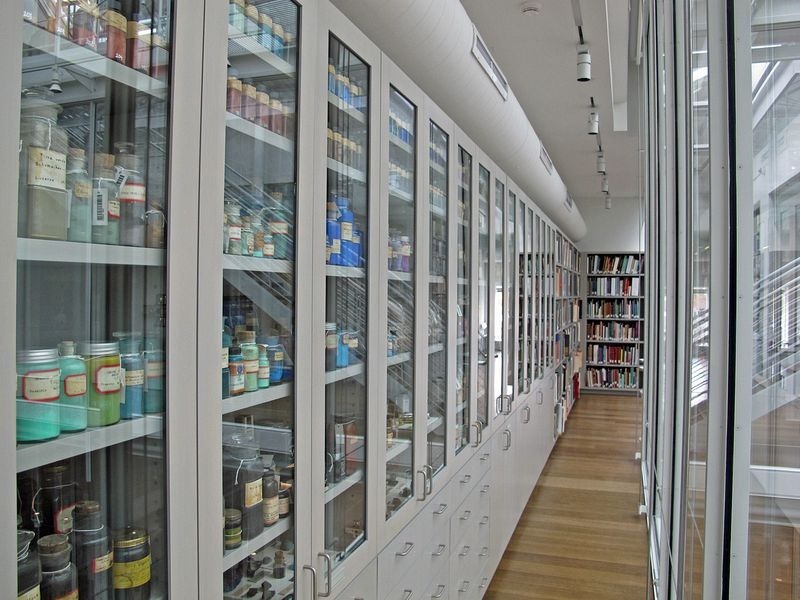A piece of rare lapis lazuli stone from quarries in Afghanistan, secretions from on ocean-dwelling snail Bolinus brandaris, dried bodies of tiny insects Coccus ilicis, and a ball of “Indian yellow” made from the urine of cows fed only on mango leaves, are just some of the bizarre treasures housed in the long row of cabinets in the Harvard Art Museums’ Straus Center for Conservation and Technical Studies. This remarkable materials collection, some of which date back more than a hundred years and come from all over the world, represents raw materials from which pigments, dyes and binding media were traditionally made before synthetic pigments became available.
The famed Forbes Pigment Library was compiled by Edward W. Forbes, former director of Fogg Art Museum, between about 1910 and 1944. Forbes’ interest in pigments and its preservation started with his purchase of the 14-century Madonna and Child with Saints, which he bought in 1899 during a trip to Italy. Forbes noticed that the painting, as with all early Italian paintings in his collection, was rapidly deteriorating which urged him to begin a passionate exploration into the process of how paintings were made. That passion led to his collection of materials related to the making and restoration of art.
By the end of the 1920s, Forbes had amassed a huge collection of pigments which he had acquired from his travels to Europe and the Far East. While in India, he collected “Indian yellow” which was used for centuries, but stopped being made because the process was harmful to cows. From Afghanistan he acquired the precious lapis lazuli stone which in Medieval times was said to be six times more valuable than gold. He also brought with him nuggets of artist pigments discovered in the excavation of Pompeii.
When Forbes founded the Center for Conservation and Technical Studies in 1928, he had over 1,000 pigments in his collection. Today, it has over 2,500 samples and is renowned in the art community. In addition to offering a phenomenal display of color and a glimpse into the history of pigments, these pigments also help experts to research, authenticate and restore paintings.
Prior to the renovation and expansion of the museums, the bulk of these materials had been stored away from public view. They are now displayed at Harvard Art Museums in rows of glass cabinets with their contents stored in their original delicate glass containers.

A rich blue hue prepared by grounding the precious lapis lazuli stone mined from quarries in Afghanistan
Another expensive pigment known as Tyrian purple is prepared from the secretion from the predatory sea snail Bolinus brandaris (originally known as Murex brandaris). Its high cost rendered it a status symbol, and Byzantine emperors forbade anyone outside the imperial court from using the violet dye, lending it the distinction “royal purple.”
The use of tiny metallic flakes suspended in a binding medium can give artworks a shining finish.
Artists often took risks to create their works, using poisonous pigments like emerald green to get the color just right.
The red-orange realgar is derived from arsenic sulfide minerals.
There are samples of kermes, an Old World pigment created by grinding tiny blisters produced by the insects Coccus ilicis, which lived on the kermes oak tree. Kermes is also the source of the word “crimson.”
Sources: Harvard Art Museum / Harvard Gazette
























Thanks for yet again another interesting article! :-)
ReplyDeleteGreat stuff!
ReplyDelete